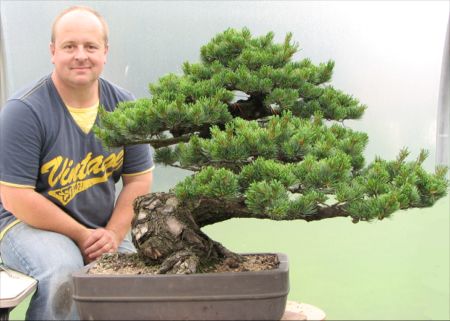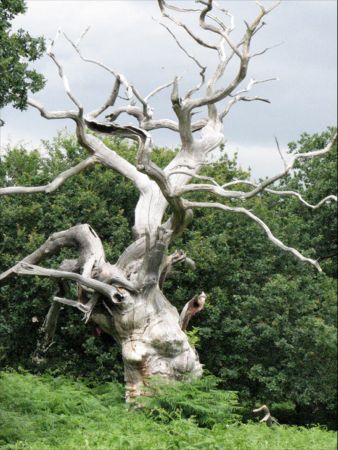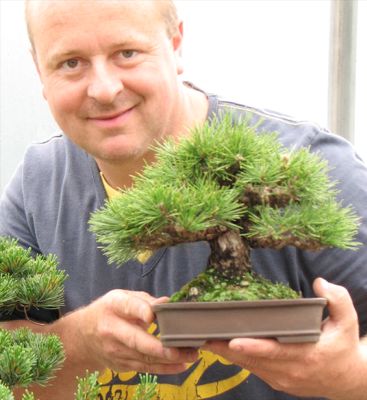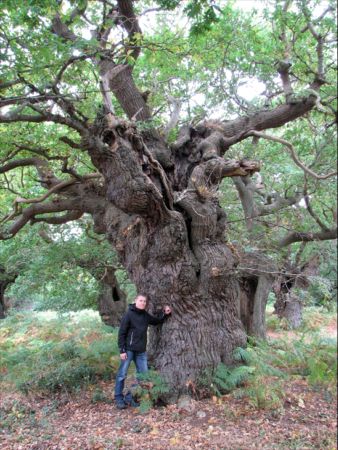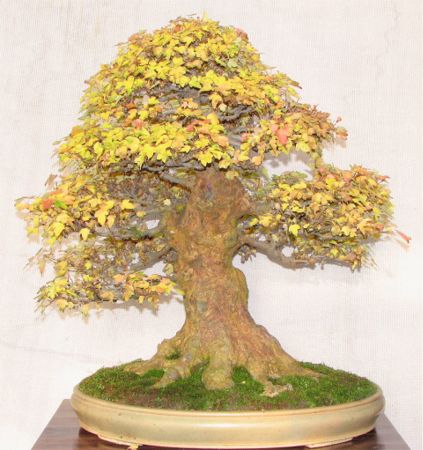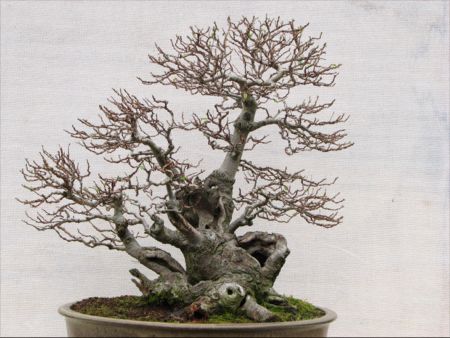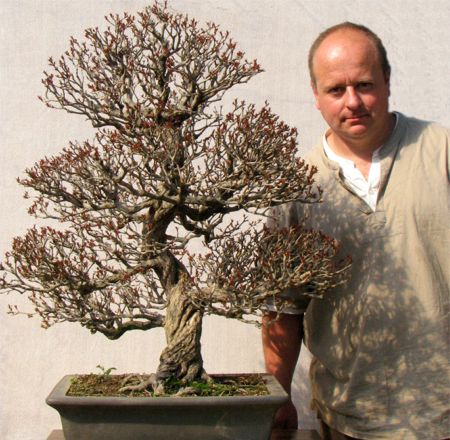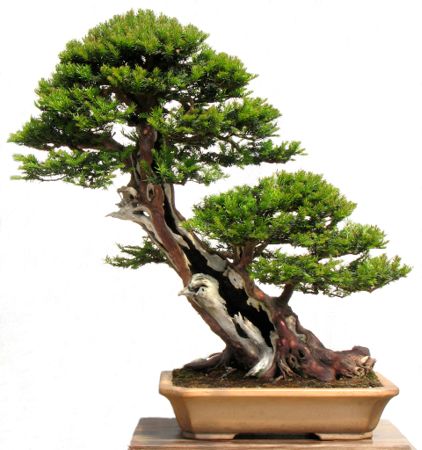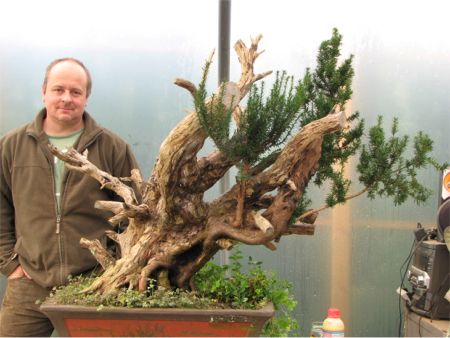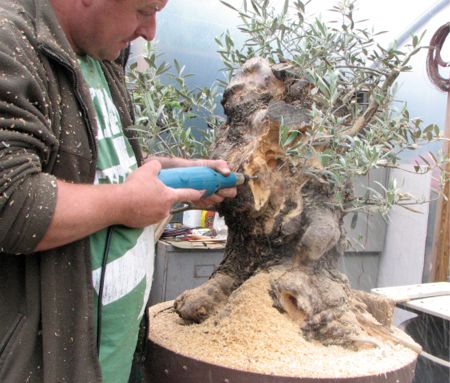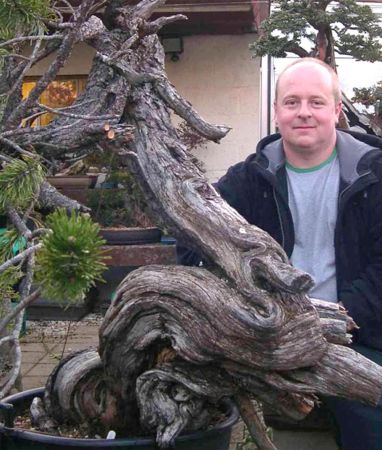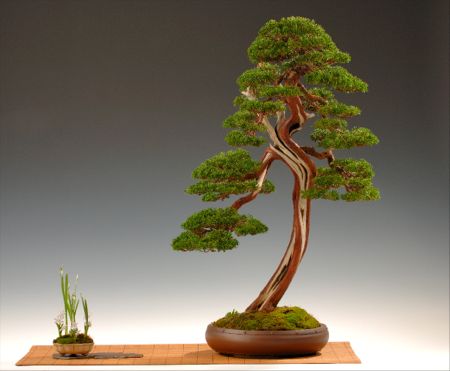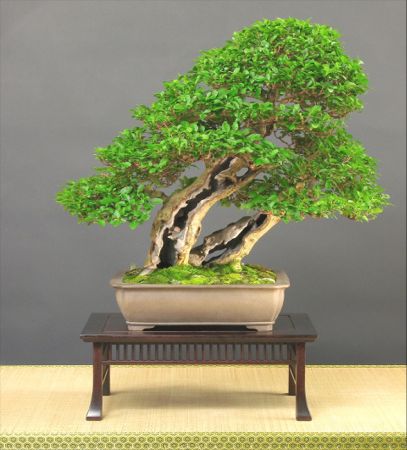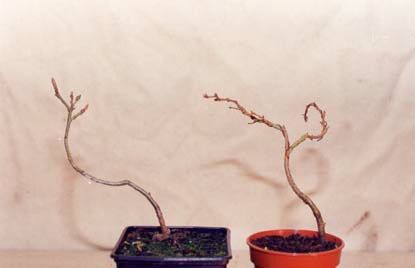1) What is bonsai like in the UK today? What would you like to see more of there and what would you like to see less of?
In general I would say that bonsai, as a hobby is growing quickly in the U.K, that’s a verifiable fact.
I would like to see more “great” bonsai in the U.K. Compared with other parts of Europe I see the quality of bonsai in the U.K steadily declining. We do have some very talented artists here that are making some very pretty bonsai. However a trip to Italy or Spain in particular brings into sharp focus the fact that we are dragging our heels. The quality of work here is every bit as good as in those countries but our base material is not (in general) so good; the very best work performed on mediocre material cannot produce truly great bonsai. You can’t make a silk purse out of a pig’s ear.
What would you like to see less of? Bad information. The web is awash with terrible, flawed and downright erroneous information about our “black art”. Almost daily I get phone calls from beginners at their whit’s end. Having spent time surfing the web and reading the half baked ideas of self proclaimed “Bonsai Masters” they are left confused and thoroughly discouraged and with their youthful enthusiasm deflated.
I would like to see more young people working at bonsai in the U.K. The average age of bonsai hobbyists in the U.K is 40-56. The demographics for our YouTube content show that 13-17 year olds do not watch our movies. 18-24 year olds are occasional viewers but, 70% of viewers are 40-56. Incidentally, 91% of our viewers are male. Having spent over 20 years fanatically practicing bonsai I feel that I am just getting to grips with the beast. If I started at my age now (45) I doubt I would have the relentless drive needed to succeed. Our youth are OUR future and the future of our wonderful hobby. Kaizen Bonsai have just taken our first young apprentice under our wing and he will be here training, non stop, for a year. He’s Dutch!
2) You studied under Kevin Wilson, who changed your outlook on bonsai and steered you in a new direction, what was it like learning from Kevin?
In early 1999 I was on the verge of walking away from bonsai for good. After many years of working with plants I felt dazed and confused by so much bad information. In those early years I had learnt a great deal about cultivating bonsai and could grow most anything and, whilst that’s the vital foundation for success in bonsai all I had in my garden were a bunch of healthy bushes in pots. I was aching to go further but didn’t have a clue what to do next. After all you don’t know what you don’t know and I couldn’t figure our what I needed next.
As the old proverb says “When the pupil is ready, the teacher appears”. In spring 1999 I got a call from a friend at the local bonsai club asking if I wanted to take up a vacant place on a group workshop with someone called Kevin Willson, a name I had never heard. After a little arm-twisting I agreed. I was told to take something that needed styling. The next week I turned up at the rendezvous and four of us headed off.
The bunch of guys I travelled with were all somewhat older than me and a bunch of wind up merchants. By the time we arrived, I didn’t know whether to expect Paul Daniels or the anti-christ. Upon arrival, I unloaded the car whilst everyone headed into the house. I hung around outside with the stuff and could hear a lot of shouting and laughing inside, obviously we had arrived much to early! A while later the workshop door opened and around its edge appeared Kevin’s face. He looked at the tree I had bought, looked at me and in a shout of exasperation said ‘****** off’ and promptly disappeared inside again. That kind of set the tone for our relationship. Working with Kevin was a rollercoaster ride of deep spiritual moments and raucous banter. FANTASTIC!
At this point I should explain that, at the behest of my so-called mates I had taken a huge wild garden juniper over 3 feet tall and four feet wide to a single day group workshop. I later found out that trees like this need a couple of days to tackle!
Despite my ineptitude and misguided folly Kevin was an absolute trooper and we finished the tree late that evening. I trusted his guidance implicitly and worked my fingers to the bone (and got sun stroke into the bargain). During the day a bonsai was born from a bush. The tree is still going strong in the collection of one of my friends.
That day quite literally changed my life forever. Every single aspect of my life has changed since and for the better. From that day I have never looked back but forge ahead with my bonsai and the way of life it brings.
Over the next eighteen months I visited and worked with Kevin at every opportunity. Kevin has a relentless work ethic towards bonsai and I am sure he would crawl over broken glass if it were necessary. Kevin introduced me to the “art” in bonsai and I will be forever grateful to him for doing so.
3) You have said, “A beautiful bonsai is one that is in equilibrium and this can only be achieved through the bonsai artists sympathy for, and mastery of the existential.” Could you explain this in more detail?
I feel that beauty in bonsai is more than skin deep. Trees are living, breathing things that have the ability to out live their keepers. In today’s world of instant gratification and disposability, bonsai stands apart. To achieve beauty in a bonsai context takes time and skill, often many years. As I travel around I see a lot of bonsai trees. At exhibition they are preened and polished and turned out in their tuxedos, wearing their expensive pots and tables like Hollywood A-listers in designer labels. The fact that a tree looks like a bonsai does not make it bonsai.
I feel that in order to bring out the ultimate beauty of a tree requires more than mastery of wiring and pruning and some expensive accessories. When we begin to create bonsai trees we seek to shape the tree externally by use of clever technique and subjugate our material. However I believe we need to work with the tree and whilst bonsai technique will take us a long way down the road real beauty comes from within. I like to think that trees yearn to be beautiful and it’s the bonsai artist’s job to allow them to be just that. Following an extensive period of work, a tree will need time to adjust and adapt and that’s the point at which the real magic happens. All WE can do is point the tree in the direction we would like it to go.
I recall Danny Use saying that unless a tree has been in a pot for 10 years it can’t really be considered bonsai. Indeed many great Japanese bonsai have spent 30 years and more in their pots. To me a truly beautiful bonsai is one that is relaxed and settled in its form having yielded and adapted to the outside influences that have acted upon it to create its form. The trees roots should be healthy and active and this will always be visible in its foliage and growth pattern. Only when a well-executed tree reaches this serene state can it truly be called bon-sai. The skill of a bonsai master is in achieving and maintaining this balance.
4) You have wrote about a few Urban Yamadori trees you have worked with, do you think that this is a viable source of material and does such offer different challenges than wild Yamadori?
I dislike that term. Yamadori means a wild tree that has it’s own magical character created by years of battles against the environment. The magic such a tree posses is a unique and very special thing that the bonsai artist must maintain and enhance through sensitive work. The wide use of the term has led, as with most phrases in common use, to a dilution of the meaning and a reduction in the value and respect given to these very special trees. That little grumble aside, I still love to work with garden plants and nursery material. Most of us have a fairly limited range of species available to collect in our own areas. Garden plants offer much greater diversity. Some of my best-known and successful bonsai have come from this type of stock. In general garden plants lack the magic of yamadori. But rather than a negative I believe this to be a positive attribute because it gives the bonsai ‘artist’ a near blank canvas to be truly creative.
5) It is well known that you appreciate a challenge and your work with a couple of trees no one else wanted has inspired many. Is the challenge all there is or do you see things in a tree that others cannot?
A good friend of mine is a very successful painter (the artistic kind). He teaches workshops regularly and one of his students complained she would never be as good a painter as Tony. His reply was to ask how many paintings she had completed that week! Experience is the greatest teacher I have ever met. I ruined a lot of plants in the early days and styled a lot of awful bonsai but, every one was a part of the foundation I continue to build upon. Creating bonsai comes from within you. It’s very important to cultivate your appreciation of wild trees and natures infinite variety. Once you have an extensive library of images in your mind and a deep understanding of how trees fit into and respond to the world around them all you have to do is master a few simple techniques, do away with some silly mis-conceptions and enjoy yourself creating small trees. Forget bonsai, be a student of nature, the lessons you need are written all around you.
I am a die hard Englishman and we are suckers for a lost cause, we love to back the underdog. I must confess to a perverse sense of excitement when I see a scabby old stump in a bucket. I am privileged and a little spoilt these days and have a lot of beautiful yamadori to work on but nothing fires me up quite as much as the statement.. “What the f*** you going to do with that piece of crap!”
6) One thing that is readily noticed when looking at your bonsai is that you deal with a wide range of species and seem to specialize in none. Do you have a favourite species that you prefer and what makes it so?
I get bored very quickly: I have the attention span of a house-fly. I love the challenge of constantly working with new species and mastering the cultivation of new varieties. I don’t really have a favourite species. The variety in our nursery changes every week and that keeps it fresh. At the moment I am in love with Mediterranean species. Ceratonia, pistachio, quercus suber and in particular cupressus sempervirens. Another favorite is arbutus. These trees make me want to get up early in the morning and get to work.
To me the most exciting and fulfilling tree to work on is a healthy one. I adore strong healthy trees that grow well and respond to training. In such a situation you feel like you are in partnership with a good friend and the development of the tree progresses with ease. Sadly I see relatively few exceptionally healthy bonsai.
7) Other than the well-known story of the time you stopped to relieve yourself on a wasp’s nest, what are the challenges of collecting in your area?
Actually finding something in the first place. I live in a big arable farming area with huge cultivated fields and very little woodland. The soil here is deep and fertile, trees grow very big given the chance. Old trees have long and incredibly deep roots which make for a challenging task actually collecting something alive.
The flip side is that if I find a yew with a 12” diameter trunk it’s probably less than 30 years old and therefore still has it’s youthful vitality which pretty much assures it’s survival. I love collecting but have come to realize that even a very good tree will still take more than 10 years to become a youthful bonsai, even in skilled hands. I fear a lot of beginners miss this aspect. I collect a lot of trees every year but also think it’s important to buy much more mature trees. Life is short and time flies by so quickly. Buying a tree can shorten the time-scale to produce magical bonsai by decades. Having bought a good tree I like to improve it and make it my own. This is every bit as challenging and rewarding as turning a tree you collected into bonsai.
8) Have you seen a decline in quality collectable trees over the years?
Absolutely not. As a deep appreciation of what makes great bonsai grows in our consciousness, I think we are driven to ever greater lengths to obtain the best material possible. I have been privileged to visit some spectacular places and have seen trees that simply defy description. Many European collectors are pushing the boundaries by collecting wonderful material. This in turn brings new challenges to top bonsai artists to really push the limits of what we can do and also what is acceptable. Bonsai, as with most things in life, is progressive. Material that was considered of high quality ten years ago is probably mediocre today. I often hear folk complaining about the price of good yamadori today. However, if you consider the quality of bonsai it is possible to make with such material and the ultimate value of the finished tree compared to what we were all working on twenty years ago I think that trees are still very reasonably priced.
9) As the years go by and more people are introduced to the art of bonsai, do you foresee a time when, like in Japan, the resource of collectable trees in the wild will be depleted? Will bonsai ever be the same without access to environmentally shaped stock that is hundreds of years old?
Not in our lifetime. Consider that Japan is a tiny and massively populated little bump in the ocean. Here we are beginning to see a spectacular movement of bonsai material from all four corners of the European land mass. That gives us a potential pool of billions of trees both yamadori and nursery stock. Besides I fear society will unravel itself long before we run out of bent trees but, I’d better not go down that road!
My major sadness in bonsai at this time is the way in which great yamadori is being snatched out of the mountains and hills with complete dis-regard for its true value. As I have travelled around I have seen hundreds of spectacular trees lying dead simply because someone was in too much of a hurry to “have” a special tree. Great yamadori takes hundreds of years to develop and I think it’s worth taking the trouble and time to ensure its survival. It’s just criminal what goes on but, there are a small number of very skilled collectors working, their trees cost more but what use is a dead tree? I have been VERY badly burned by yamadori bandits. Now I only buy trees from good collectors that are well established in their pots. A huge amount of yamadori for sale has only been in the pot for a few weeks, much of it has not actually grown since collection. All I can say is if you are going to buy yamadori make sure it’s guaranteed and has been in the pot for at least a couple of growing seasons.
My first contact with real ‘yamadori’ was via’ Dave Prescott who drove me mad going on about its unique and special character. At the time I just didn’t get it. My appreciation of good material was not sufficiently honed and I thought he was being a snob since he had a great collection of yamadori and I didn’t. That was nigh on ten years ago. Today I do the same, yamadori has heart and soul and capturing its unique character has become the central preoccupation of my bonsai work. I don’t care how good Japanese nursery bonsai is it really can’t capture the emotive spirit of great yamadori. I love Japanese bonsai and do have a couple in my own collection but I have come to believe that we can develop a link with yamadori at a very deep level. For me the magic of yamadori is in its victory in the battles fought against the elements. Every twist and turn tells a story of triumph over adversity. That inspires me in my life every single day. So, in answer to the last part of this question. NO!
10) You are a proponent of using seaweed extracts in bonsai cultivation, can you tell us more about this and why you feel it is so important?
Seaweed per-se is not especially important but good plant nutrition is. As I mentioned at the beginning my first years in bonsai were spent learning to grow plants in pots and to improve and then maintain their health. Over those eight years I began to learn what worked and what didn’t. I was constantly pushing the boundaries of what I knew, in time I became very successful both at establishing newly collected stock and restoring old and sad bonsai trees. In that time I learned what worked but didn’t exactly know why. Later I studied horticulture professionally and in doing so put the last piece of the puzzle into place by learning WHY what I was doing worked.
In order to be successful at bonsai it is necessary to have a good understanding of a number of different disciplines, both artistic and horticultural. My own opinion is that the latter is of most importance. If you can’t grow trees and if you can’t maintain their health over decades you simply cannot make bonsai, I don’t care how ‘artistic’ you are. Central to any efforts to create bonsai must be good quality horticultural practice. Keeping healthy bonsai in a clean healthy environment requires effort and understanding. Good nursery practice is essential. Obviously a part of that practice involves good plant nutrition. Our plants grow in a very small amount of soil that has almost no inherent nutriment. The application of fertilizers is an area of great, and heated, debate among all bonsai enthusiasts. Plant nutrition is a complex subject to understand but the basics are quite simple.
1. Plants require a variety of nutrients, these are absorbed as chemical compounds diluted in water.
2. Plants need nutrients every day, more when their activity levels are higher.
3. Give your plant everything it needs and it will be in peak condition.
I once read, in a book by a well know author, that it is necessary to use a good, balanced chemical fertilizer for bonsai at half strength once a month. That makes me angry because countless beginners at bonsai have followed that advice which is a bit like asking you to live an active lifestyle when all you get to eat is a couple of sandwiches each month. Bad information like that is everywhere and, whilst it doesn’t stand up to scrutiny, beginners have a habit of believing what they read and, things picked up in our formative years tend to stay with us and become entrenched in our thinking.
I have found that most bonsai trees I see are under nourished and ailing due to a lack of balanced nutrition. This effects every aspect of a trees wellbeing, including disease resistance. Seaweed products are a quick and very effective way to restore nutrient and mineral deficiencies in such cases and should certainly form part of a well balanced fertilizing regimen.
As to whether seaweed products have any magical properties I don’t know. What I do know is that if your trees are in good soil, cared for well and fertilized properly they will have all the magic they need.
11) Foliage feeding and its effectiveness, or lack thereof, is a highly debated subject on-line. You have stated that you support the practice. Will you share your thoughts and experiences on why you think this practice is effective?
Simply put it is a scientifically provable fact. Plants do absorb nutrients through their foliage. However bearing in mind my answer to the previous question, if your plants are strong and healthy the benefits of foliar feeding may not be blatantly evident. Again foliar feeding is just one way of helping our plants to do well and can be of particular value in special circumstances, for instance it the plants roots are in poor condition.
I have had a number of trees come into the nursery over the years in very poor condition. This can be down to a variety of factors. However ultimately it means the plant is weak. Often a plant is too weak to really get to grips with it’s core problem, for instance poor soil or damaged roots. In that case I like to control the trees environment very carefully. This involves a very careful balancing of the moisture in the soil and control of exposure to wind and sunlight. His gives the plant time to improve it’s vigor and can take a number of years to build sufficient strength in the plant to be able to progress with the real problem. Foliar feeding can be a vital part of restoring such a plant.
12) Your expertise in carving bonsai is well known. It is said that by some of your students your approach to carving is different than the standard norms. You focus on the carving first as a focal point in the design. Then address the foliage as a highlight to the carving. Could you elaborate more on this.
My approach to bonsai is simply to try to make the best tree possible from the material I have in front of me. If carving is required then I try to do it in such a way that it looks like it belongs to the tree in question. Carving for it’s own sake will not make a better bonsai, especially out of poor material. I think carving, especially with power tools, has a bad image because it has been used, indiscriminately, by unskilled demonstrators who should know better. Carving is a useful tool in the creation of bonsai with certain types of material.
13) Many practitioners use lime sulfur or other chemical means to bleach the deadwood on their bonsai a stark white color. While this is a natural appearance in some desert environments, most natural deadwood is actually found in various shades of gray. What are your thoughts on what makes visually pleasing deadwood as far a color is concerned?
Most deadwood needs to be preserved, especially in the U.K where the winters are mild and wet. Lime sulphur is probably the most effective wood preservative for use with bonsai trees. However, after a couple of applications, it will not be necessary to treat the wood very often and leaving well alone will allow the wood to take on a more natural colour. The best element in colouring deadwood is time.
I do not like to see white deadwood on deciduous trees, I don’t, in general see that in nature. However I have seen snow white deadwood on an English oak deep in the woods. I have also seen green rotting wood high in the mountains. There is no right or wrong in nature and what happens in nature should be interpreted into bonsai.
It amazes me how much effort is expended in arguing opinions over matters like this, especially online. I think that if you want deadwood to be a natural colour leave well alone and let nature take its course. However you may have to be prepared to adapt if nature takes the tree in a direction you were not planning upon. After many years I have come to the realization that practicing bonsai is a very individual thing. Once you have learned the ropes just do your own trees, that inspire you, and don’t worry what everyone else has to say.
14) Against what some would call tradition, you incorporate deadwood into many species where it is not often seen such as your Twin Trunk Privet. What are your thoughts on deadwood use on deciduous species and other species not usually shown with deadwood?
I can show you thousands of pictures of spectacular hollow deciduous trees in nature. Wild trees have a very complex relationship with the fungi they support and that eat away their heartwood. We have no comprehension of how these relationships work. It is a provable fact that a hollow tree in nature is more easily able to withstand the ravages of a storm than a maiden tree. Some authorities are beginning to suggest that a tree could, at some level, encourage the fungi that hollow it’s trunk. Once hollow it can expect a much longer life producing seed simply because it is less likely to be blown over.
Again years ago I read in a book that deadwood had no place in deciduous bonsai. The author had evidently never seen a tree in the flesh. Even the trees in my garden have deadwood on them. Where the confusion happens is in a little differentiation I like to call “high mountain” versus “lowland” deadwood. Twisting spiraling bleached white jins and shari look good on junipers, pines and other conifers and mountain trees. Dark rotting hollows look good on broadleaf trees. And, whilst the two styles of wood are not mutually exclusive and do, at some point cross over, the general differentiation is sound.
As I said earlier, deadwood does not make a good bonsai but, then again, some bonsai cannot be made without deadwood.
15) You are a strong advocate of bonsai workshops and have wrote that you feel they are an important part of advancement in the art for beginners and experienced practitioners, could you elaborate on these thoughts?
I have already made issue over the subject of how bad information gets ingrained into the thinking of beginners. Nowadays there are a mind-boggling array of websites and information sources available. Whilst many are very good, just as many are simply appalling and conspire to leave the newly initiated bonsai enthusiast in a confused daze of opinionated fog.
As a complete novice I know it is very difficult to know where to start, as I said earlier you don’t know what you don’t know, therefore how can you decide what you need to learn? I certainly spent my early years stumbling around in the fog of dubious opinion. I went to a number of workshops with so called experts, read a lot of books and listened to anyone I could talk with. Everyone was telling me different things and with my lack of experience it was not possible to arrange everything I learned into a coherent strategy. The result was that after eight years I was so disillusioned with bonsai that I was ready to walk away. In retrospect I had come a long way and learned a great deal but, everyone was telling me different things and so I was mired in self-doubt and my confidence and enthusiasm were gone.
That’s when I met Kevin, he restored my confidence and re-kindled my enthusiasm. Kevin helped me to fill in the gaps and the result was, finally, a coherent approach to creating bonsai trees. I know many people do not have that determination and fall away long before they get both feet on the ground.
Just like apprenticeships, bonsai workshops can save you years of stumbling around in the dark. Learning from a good teacher is a great experience and gives you a depth of confidence that otherwise would take decades to acquire. Bonsai is a progressive thing, and learning the craft should be too. One of the main causes of failure in bonsai is going too quickly. Sadly this happens a lot, folk start buying expensive trees that are way beyond their capabilities. It only takes a couple of expensive losses for many folk to walk away.
The secret to learning from workshops it to select a good teacher in the first place and that’s tricky. Initially it’s quite easy to judge the quality of work performed by your perspective mentor. Trees speak louder than words ever will. Kevin always taught me to judge what people told me in light of the trees on their benches. That way you can weed out people who just ‘talk a good tree’.
Finding someone who is capable of actually teaching bonsai is going to be much more difficult. A good bonsai ‘demonstrator’ is not necessarily a good teacher. The more people you can work with the better. In time it will be plain who to choose as your mentor.
So “yes” I am a strong advocate of workshops. Not only because it gives you a chance to learn from a more skilled person but also because of the interaction between everyone on the workshop. A small group led by a skilled teacher is a very positive environment and a powerful learning opportunity. BUT, beware of large groups. Many event organisers host workshops with up to twelve participants. Unless this is tailored to a particular facet of bonsai it’s going to be very difficult to learn much, always pay more and join a smaller group.
There comes a time when we are well versed in the techniques of our art and we get comfortable. As a teacher myself, I know there’s always a danger of getting overconfident. Spending time learning from others is always a positive experience that keeps our own skill in perspective. So, no matter how high we climb I feel it’s vitally important to constantly work with other people. That way we can continually hone our skills and improve our abilities.
16) You have suggested that we are overly concerned with rot and treat it as an invading disease, instead we should realize that rot is an important part of a trees defensives and that we should look more carefully at trees in nature instead of trying desperately to heal over a wound on a bonsai. Could you tell us more about your thoughts on this?
I refer you back to Q14.
17) In your highly successful Internet business, Kaizen Bonsai https://www.kaizenbonsai.com, have you seen growth in bonsai since its inception and what trends have you noticed forming?
Certainly our business has grown, business has increased five fold in the last six years. I can also say that bonsai as a hobby is expanding all the time. Thanks to the internet more people are finding bonsai and having a dabble.
Regarding trends it’s difficult to draw any firm conclusions, we have near 20,000 customers from all over the world and, of course, everyone is at a different level and looking for different things from their bonsai experience. Two trends have become plain though.
Firstly one of the most obvious and shocking trends is an overwhelming ignorance of horticulture. I come from a long line of gardeners and was growing plants by the time I could ride a bike. I think recent generations have lost the link with nature, plants and the seasons. That’s very sad and also difficult to overcome but does offer a key to why bonsai interest is increasing. I think there is something deep within us all that longs to be connected with nature and the cycle of life. However it does mean that newcomers to bonsai have a lot to learn before they begin to enjoy any real progress. I am adamant that the most important aspect of bonsai is the ability to maintain a healthy tree. It breaks my heart to see nice trees getting an absolute spannering, very often by people who should know better. Allowing the natural beauty of a tree to shine out requires a quiet insight into the magic of plants that is often drowned out by the need of some to impress others. We need to learn to love plants with a passion. In doing so we learn to respect our trees and their life force. Bonsai is becoming a hands on form of entertainment and a way to impress our peers. I work on the principle that we can force a tree to be bonsai, subjugate, manipulate and control, or we can encourage it to be beautiful from within. All we can do is point the tree in the right direction and, having provided for all it’s needs, wait patiently for the bonsai to shine through.
The second trend is a raging lack of patience and the less I say about that the better.
18) Do you feel that interest in the art of bonsai has peaked or that the growth will continue? Why?
I’m sure we will see a steady growth in bonsai over the coming years thanks to improved access via the internet, magazines and shows.
19) Bonsai seems to be on a difficult path in obtaining recognition as a legitimate art form, sadly even with practitioners of the art. What do you think needs to be accomplished in order for this recognition to occur?
You probably won’t like this answer….. I try to avoid these sorts of questions. Diverting the effort into actually creating bonsai has been much more productive for me.
For years there has been a raging argument about whether bonsai is art. My own view is that bonsai is 95% craft with a little artistic insight floating on the top at the highest level. Art is something that is given value by people. The fact that an exploding shed is given credence, or that a slop of paint on a board is considered valuable just goes to show how daft we have become. Personally I don’t think bonsai will be recognized as an art form. It’s just too hard to accomplish and that skill is simply not recognized by people that are educated beyond their intellectual capacity. But, just a few are able to enjoy an insight into nature and the struggles trees endure in their fight for survival. That inspires us in our daily lives to keep on fighting against all the odds. Ultimately everything dies, what inspires me is the way in which life can overcome adversity in spite of it all. I couldn’t care less whether that fact is recognized by others. I do my bonsai, for me, if along the way somebody else can take inspiration from that I’m happy for them.
20) What do you see happening in the bonsai community today that is raising the level of the art? What do you see that may be hurting it?
Top quality shows like the Ginkgo exhibitions and the Noelanders Trophy are transforming the appreciation of bonsai. It’s vital to see top quality bonsai in the flesh in order to appreciate their gravitas. Looking at pictures is not a substitute because they cannot portray the three dimensional aspect of great designs. Also a good tree has a powerful presence all it’s own that cannot be transferred by a picture. It’s a great privilege to be able to attend these events and I have nothing but respect for the people that work so hard to put the events on. We need to support these shows!
Ego’s are hurting bonsai and killing trees. It’s an easy trap to fall into. There are too many people doing bonsai to make themselves look good at the expense of the trees. Some demo’s give the impression that miracles are possible. As the old saying goes…the impossible we can do, miracles take a little longer.
There needs to be more focus on respecting the life of our trees. It seems to me that the Japanese learned this a long time ago. We need more teaching on progressive bonsai technique and the steady year by year development of material as it grows into bonsai. Sadly this is never well received, we much prefer to be entertained. As a sometime demonstrator I have had pressure put on me to ‘finish’ a tree. I have noticed on our YouTube videos that most folk look at the starting material and then click right to the end to see the finished work, completely missing the point of the clip. We have a web survey in which the question “What aspects of cultivating bonsai do you experience most difficulty with?” appears. The answer to this is almost always “STYLING”.
I think we all need to concentrate a lot harder.
21) If you could only teach one thing concerning bonsai, what would it be?
Take your time, keep an open mind and make trees YOU love.
22) This space is for the question or questions that you wished we had asked and for your answers to them.
I think I have dug this hole deep enough already! G.
This is an unedited version of the interview that appears here http://artofbonsai.org/forum/viewtopic.php?f=23&t=3911

